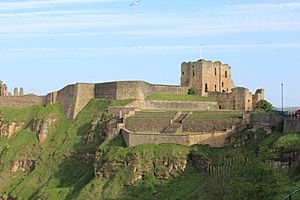Jacob Kroger facts for kids

Jacob Kroger was a German goldsmith who lived in the 1500s. He worked for Anne of Denmark, who was the Queen of Scotland. Sadly, he became known for stealing her valuable jewels.
Jacob Kroger came from a place called Lüneburg in Germany. He learned how to make beautiful jewelry there, finishing his training in 1575. His teachers were skilled goldsmiths named Tönnies Dierssen and Steffen Ulrichs. Dierssen made fancy items like decorated spoons and cups.
Jacob Kroger moved to Scotland in 1590 with Anne of Denmark and her husband, James VI of Scotland. He was part of the Queen's household, meaning he lived and worked for her. He stayed at places like Holyroodhouse or Dunfermline Palace.
As the Queen's goldsmith, Jacob Kroger made and looked after many of her jewels. An English official named John Carey once wrote that Kroger was the Queen's jeweler and kept most of her precious items.
Contents
The Queen's Missing Jewels
In April 1594, Jacob Kroger and another servant, Guillaume Martyn, decided to steal some of Queen Anne's jewels. Guillaume Martyn was a French footman who worked in the King's stables. They planned to go back to their home countries through England.
They decided to steal because they hadn't been paid for their work. They were "very weary of their service," meaning they were tired of working without getting their wages.
The Escape and Discovery
Kroger and Martyn left Edinburgh at night. They crossed the River Tweed near Kelso and were later seen near Alnwick in England. They eventually reached Tweedmouth.
An English official, John Carey, knew they were in the area. However, it took a few days for news of the theft to reach him from Edinburgh. On May 3, 1594, John Colville sent a letter to London about the stolen jewels.
Capture and Recovery
On May 6, 1594, Kroger and Martyn met the Earl of Bothwell. He was a fugitive hiding in northern England. The Earl took most of their stolen possessions.
Soon after, George Selby, the Sheriff of Newcastle, and Thomas Power arrested them. They were acting on requests from King James VI. The prisoners were taken to Tynemouth Castle, where they stayed for about five weeks.

Thomas Power described some of the stolen jewels in a letter. He mentioned neckchains and bracelets made of "ragged pearl." He also sent a list of the jewels, which Jacob Kroger himself had valued. This list included a pearl chain, a black stone heart with a pearl, and gold decorations for the Queen's gowns.
Returning the Thieves and Jewels
The English diplomat Robert Bowes wrote to William Cecil that King James VI wanted the men and the jewels back in Scotland. The King called the thieves "twa limers deuces," meaning two rascals.
The Earl of Bothwell had kept some of the jewels, including rings and bracelets. He hoped to use them to make peace with King James VI.
On June 11, 1594, Jacob Kroger, Guillaume Martyn, and the recovered jewels were handed over to Scottish officials. This happened at Norham, a place on the border.
The Fate of the Thieves
Jacob Kroger and Guillaume Martyn were taken back to Edinburgh. They had a quick trial and were found guilty. Just three days later, on Friday, June 14, 1594, they were executed by hanging.
Historians like Maureen Meikle suggest that the Earl of Bothwell might have taken the jewels to stop them from falling into English hands. Queen Anne of Denmark was an ally of Bothwell, even against her husband, King James.
After Kroger, the Queen had other goldsmiths. Later, more jewels were reportedly stolen from Queen Anne by other servants, including Margaret Hartsyde and, after Anne's death in 1619, by Anna Kaas and Piero Hugon.

